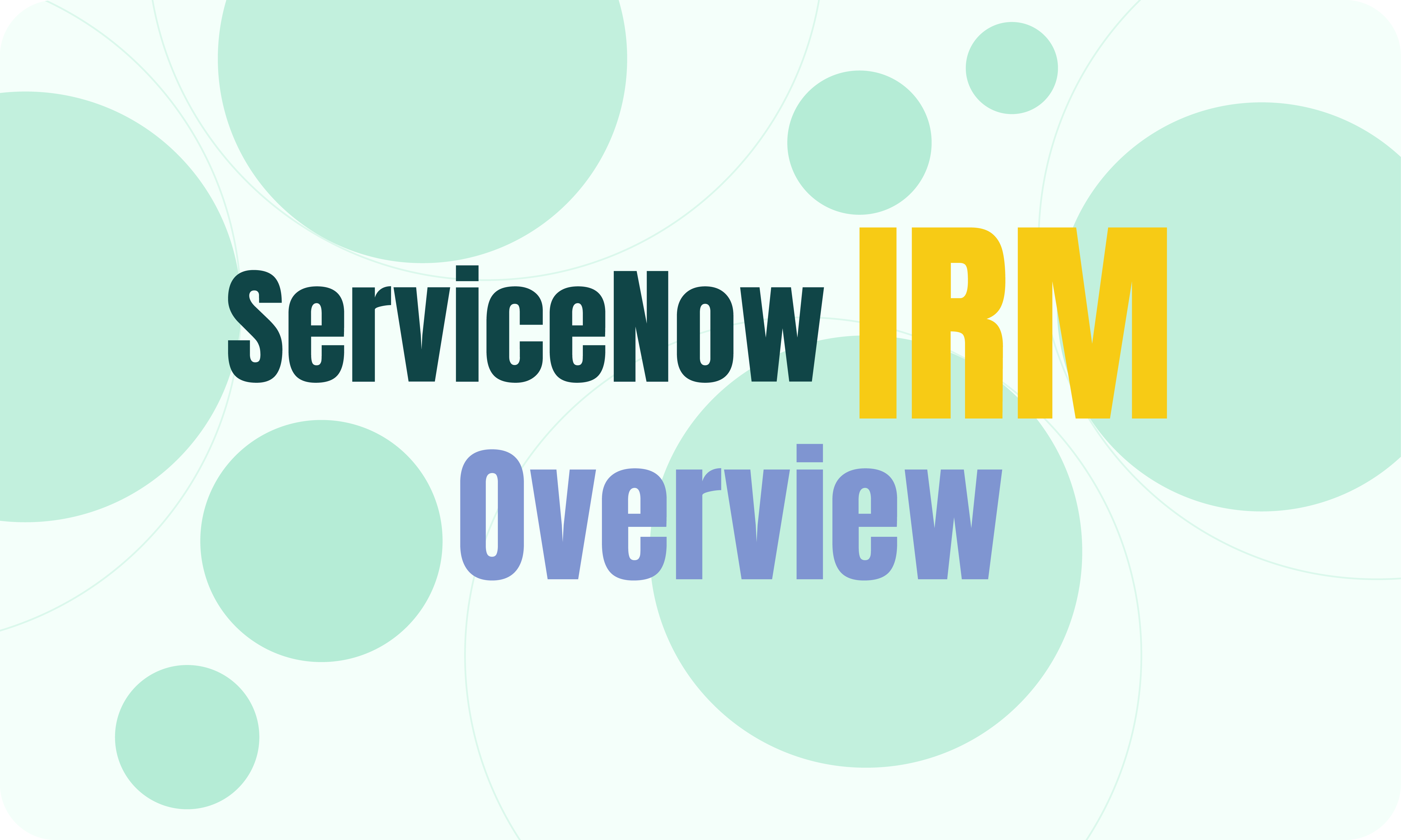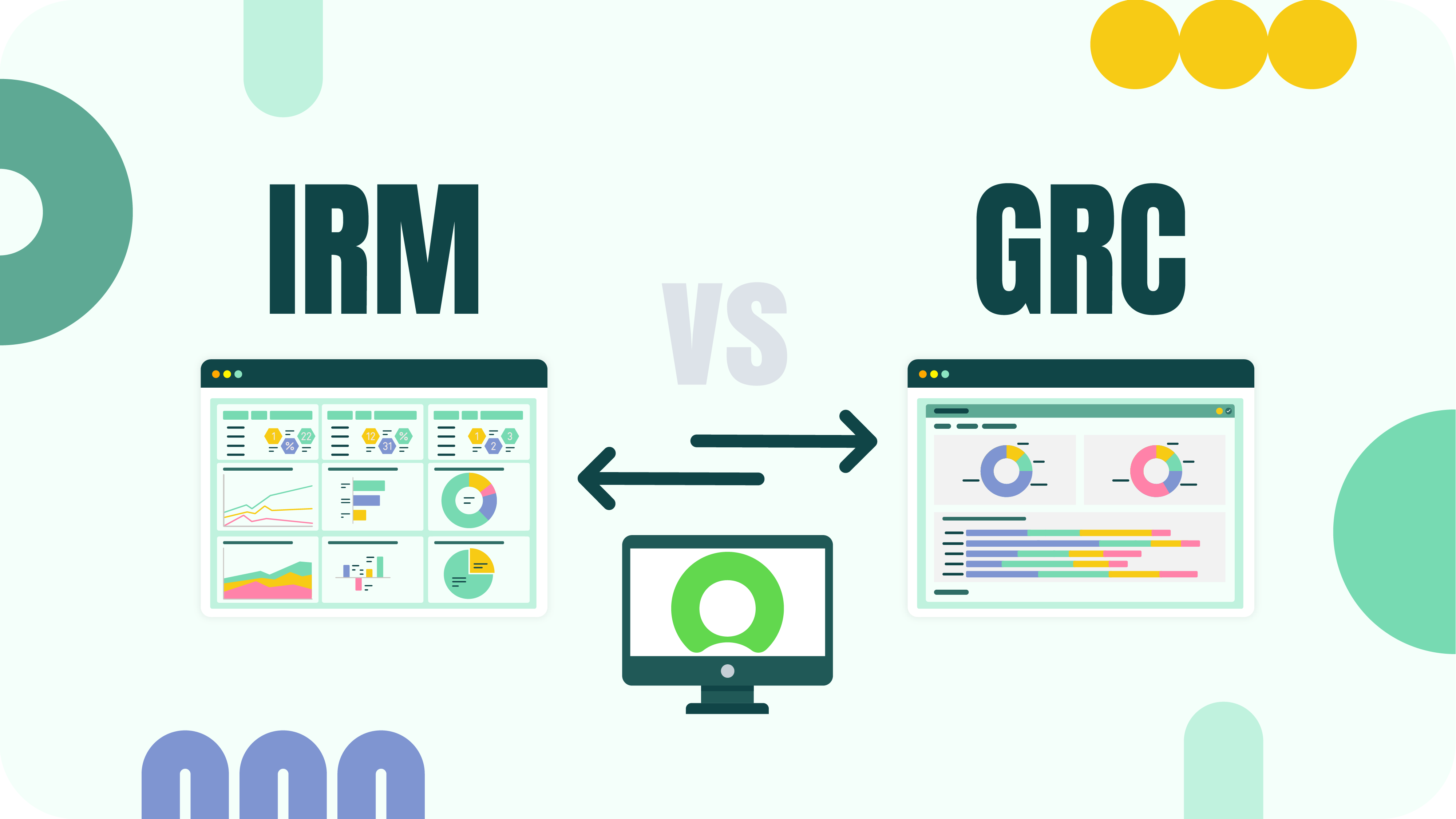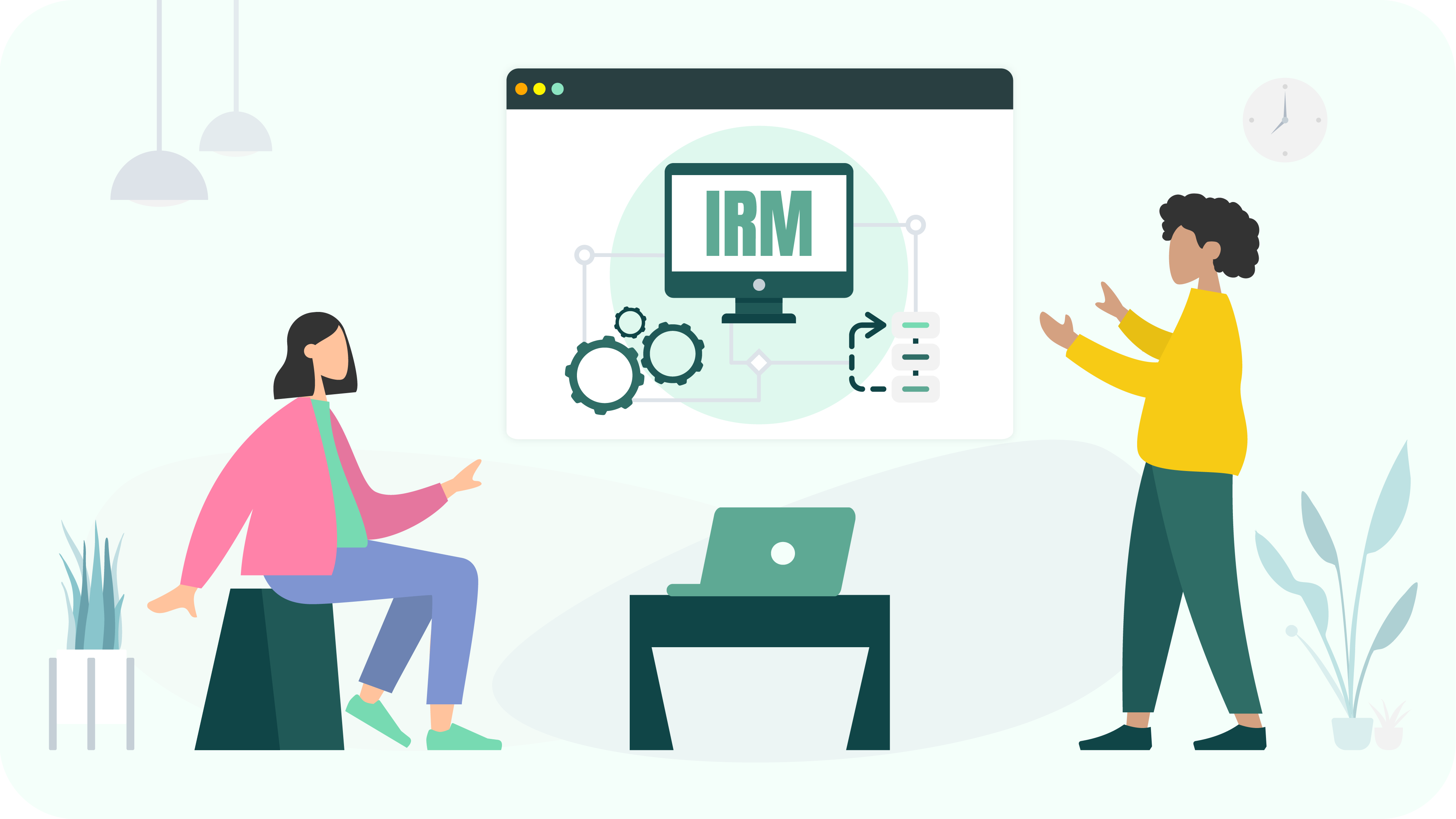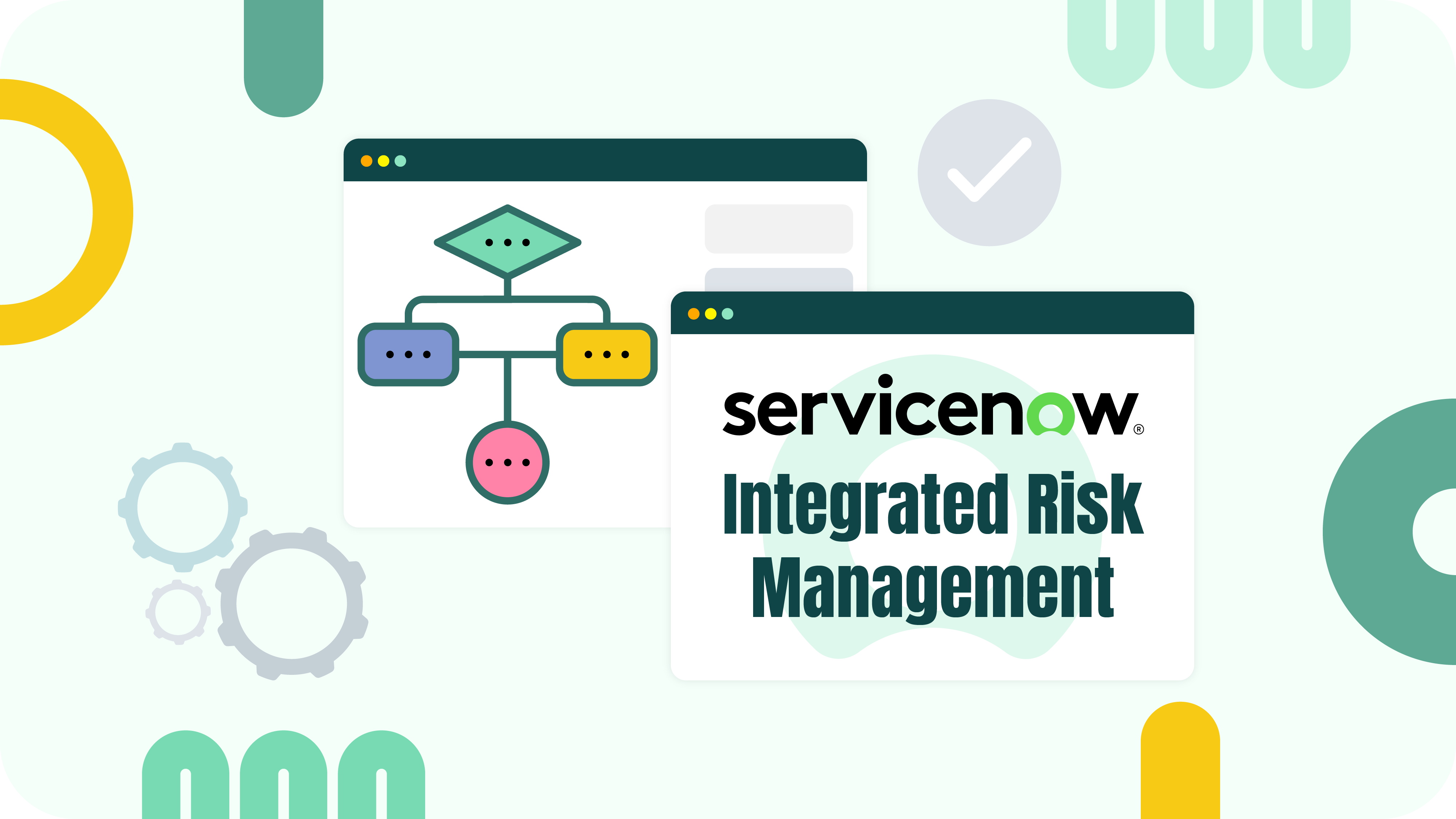Integrated Risk Management (IRM) centralizes risk activities for smoother, more effective organizational management. ServiceNow IRM provides a comprehensive set of tools to handle various risks, such as reputational, strategic, operational, compliance, and financial. This article explores how ServiceNow helps businesses stay ahead with proactive insights and smart, risk-based decisions.
- What is IRM in ServiceNow
- ServiceNow IRM vs GRC
- Why You Need IRM in ServiceNow
- Overview of ServiceNow IRM Module System
- How to Process ServiceNow IRM Implementation
- ServiceNow IRM Certification and Training
- Conclusion

What is IRM in ServiceNow
Modern businesses deal with many risks, from tech breaches and safety issues to business disruptions and reputational damage. Plus, there are uncontrollable factors like extreme weather, increasing compliance costs, supply chain hiccups, and pandemics.
Integrated Risk Management (IRM) solves these problems, moving away from old, disjointed risk management to a proactive, interconnected approach. Introduced by Gartner in 2018, IRM is defined as practices and processes supported by a risk-aware culture and enabling technologies that improve decision-making and performance through an integrated view of an organization’s risks.
But what is IRM in ServiceNow? It is a toolkit that pulls together risk and compliance data, streamlines processes, and gives a full view of an organization’s risks. It offers:
- Boosted Efficiency: ServiceNow IRM improves operational efficiency by automating tasks and providing real-time data.
- Better Risk Identification: Integrated technology enhances risk visibility, aiding in the timely identification and mitigation of risks.
- Enhanced Reporting: Real-time dashboards and customizable reports offer actionable insights, supporting intelligent decision-making.
- Simplified Compliance: Automation streamlines compliance checks and ensures adherence to regulations, simplifying the compliance process.
- Cost Savings: Through reduced manual effort and improved efficiency, ServiceNow IRM delivers substantial cost savings while scaling up to meet business needs.
ServiceNow IRM implementation will also help embed risk-informed decisions into everyday work, making the whole organization more resilient and efficient.
Key Features of ServiceNow
The benefits of using IRM ServiceNow are boosted by the platform’s comprehensive features that streamline and automate business processes. Different systems can be integrated across various departments to improve efficiency, reduce costs, and enhance productivity. Here are some key features:
- IT Service Management (ITSM): Tools for managing IT services like incident, change, and problem management. For example, if a user reports a system outage, ServiceNow can automate ticketing, assign it to the right IT staff, and track the resolution.
- IT Operations Management (ITOM): Uses AIOps to predict issues and streamline resolutions. For instance, predictive analytics can identify potential server failures before they happen, enabling preemptive maintenance.
- Customer Service Management: Automates customer requests and problem-solving for seamless experiences. It can include automating responses to common customer inquiries using chatbots or self-service portals.
- Automation Engine: This engine automates and connects processes to ServiceNow for hyper automation. It might involve automating data entry tasks across systems to reduce manual work.
- IT Asset Management: Manages software, hardware, and cloud asset lifecycle to cut costs and risks. An example is tracking software licenses across an organization to ensure compliance with licensing agreements.
ServiceNow IRM vs GRC

IRM is part of ServiceNow’s GRC (Governance, Risk, and Compliance) suit, a set of tools that help organizations manage these areas together. It aims to unify processes, manage risks, and improve resilience across the business. GRC covers policy management, compliance monitoring, risk management, and business continuity planning. It helps align business activities with goals (Governance), control and mitigate risks (Risk), and ensure compliance with laws and regulations (Compliance). ServiceNow GRC provides continuous monitoring, real-time dashboards for compliance, and automated workflows to increase productivity and reduce errors. It is scalable and integrates with other applications for a comprehensive risk management approach.
IRM, in turn, helps improve how organizations see and handle risks by providing real-time information, increasing productivity, and reducing costs with automated processes. IRM supports a complete GRC strategy by continuously monitoring risks, managing compliance, and making risk management part of the daily work experience. It includes key applications that can grow with your business, automate policy management, and prioritize risks for effective response, helping organizations manage operational risks more efficiently.
Both are crucial for organizations seeking to manage their risks effectively but focus on different aspects of risk management:
- Architecture and Design: GRC focuses on compliance with closed systems; IRM integrates into the entire organization with an open, accessible approach.
- Content and Use: GRC is compliance-focused and used by specialists; IRM involves cross-functional teams, including non-experts.
- Features and Functions: GRC tools are isolated and expanded as needed; IRM tools are integrated and comprehensive, engaging stakeholders across the organization.
GRC sets the strategic framework for managing risks and compliance, while IRM provides the tactical tools and processes to implement this framework effectively.
Why You Need IRM in ServiceNow
IRM in ServiceNow supports a proactive and streamlined approach to managing risks across the enterprise. Here are some key benefits of using it in your organization:
Maximize Risk Resiliency with ServiceNow IRM
- Enhanced Visibility: Real-time insights boost visibility into risk and compliance efforts, significantly reducing the time it takes to identify compliance gaps.
- Proactive Response: Swift adaptation to business and regulatory changes minimizes fines and operational disruptions. For instance, a manufacturing company can promptly comply with new safety regulations using ServiceNow IRM.
Reduce Compliance Costs
- Automated Workflows: IRM automates organization-wide workflows, reducing manual tasks and enhancing productivity.
- Efficient Resource Management: Automation simplifies compliance processes, reducing complexity and costs.
Save Time and Boost Productivity
- Automate Policy Management: IRM automates policy creation, updates, and monitoring, ensuring compliance.
- Analyze Business Impact: Detailed analyses help prioritize and address high-priority risks swiftly, minimizing disruptions.
Scale with Your Business
- Integrated Risk Management Program: Operational risks are effectively handled within a comprehensive risk management strategy.
- Speed Up IT System Onboarding: Quickly bring new IT systems online and continuously monitor them for compliance and security.
Deliver Long-Term Value
- Smart Decisions, Better Efficiency: Informed decisions streamline operations and boost efficiency.
- Speedy Innovation with Confidence: Rapid and confident innovation builds trust and achieves business goals faster.
Overview of ServiceNow IRM Module System

The IRM module in ServiceNow includes several key components, each offering specific functionalities to streamline risk management processes.
Risk Management
Risk management makes identifying and prioritizing risks across an entire organization easier. With continuous monitoring and an advanced risk assessment engine, it helps spot, rank, and handle risks using a unified approach. This way, businesses can clearly view potential issues and operate confidently. Key features include automated risk assessments, real-time monitoring of essential risk indicators, and straightforward risk reporting. ServiceNow also offers mobile access, AI-driven issue management, and detailed reporting tools, allowing organizations to quickly respond to changes and make intelligent, risk-based decisions.
Use case:
By leveraging the platform’s continuous monitoring and advanced risk assessment engine, a large retail company can quickly identify potential disruptions, such as supplier delays or quality issues. For instance, if a critical supplier experiences a delay, the system automatically assesses the risk’s impact on the business, prioritizes it, and alerts the relevant teams. With real-time insights and mobile access, managers can respond swiftly to mitigate the effect, ensuring minimal disruption to operations and maintaining customer satisfaction.
Operational Risk Management
ServiceNow Operational Risk Management helps organizations assess and manage risks, report incidents, and maintain comprehensive risk reporting to protect stakeholders and shareholder value. It reduces operational losses by effectively identifying, assessing, and mitigating risks and increases productivity through consistent, repeatable processes. With real-time visibility and continuous monitoring, it quickly identifies and prevents issues. Key features include risk control self-assessment, constant monitoring, incident capture, AI-assisted risk management, and integrated issue management, enhancing organizational resilience and reliability.
Use Case:
A global logistics company may use operational risk management to manage the risks associated with its delivery operations by continuously monitoring key risk indicators, such as vehicle maintenance schedules and driver compliance with safety protocols. When an incident occurs, like a vehicle breakdown, the system captures the incident details, assesses the impact, and triggers a workflow to address the issue. The company ensures quick resolution and minimal disruption by documenting control tests and monitoring residual risks.
Policy and Compliance Management
Policy and compliance management streamlines how companies handle compliance. It automates key processes, ensuring that regulations are consistently followed and quickly addressed if there’s an issue. Teams can collaborate on policy creation and approval, and controls are aligned across various regulations for easier management. Plus, innovative technology helps speed up problem-solving. It also offers user-friendly interfaces, automated checks, and simplified requests for evidence, making compliance less of a headache for everyone involved.
Use case:
A healthcare organization can use ServiceNow Policy and Compliance Management to manage regulatory obligations efficiently. Automation ensures continuous monitoring and quick issue identification, while collaborative tools streamline policy creation and control mapping. AI-driven issue management swiftly resolves any compliance discrepancies.
Audit Management
This ServiceNow IRM module helps organizations plan and prioritize audits using risk data and entity information. The platform offers several benefits, including improved audit preparation through advanced risk assessment of auditable units, the proactive identification and elimination of recurring issues, increased productivity through automated evidence collection and intelligent issue management, and enhanced decision-making through clear differentiation between issues and observations at all levels. Features include streamlined audit processes, project management tools, smart issue handling, evidence requests, and personalized workspaces for easy access.
Use case:
A manufacturing company leverages risk data to prioritize audits on critical areas like quality control and supply chain management. For example, they identify high-risk suppliers and prioritize audits to ensure compliance and mitigate supply chain disruptions. With streamlined audit project management and automated issue resolution, they effectively track audit progress and address compliance gaps promptly.
Regulatory Change Management
ServiceNow Regulatory Change Management simplifies tracking and implementing regulatory updates. It creates a unified system and connects with regulatory sources to seamlessly assess changes and monitor their progress. It helps organizations stay on top of regulatory shifts, automate tasks, and scale operations smoothly. This feature includes a simple system for finding and automating regulations, alerts for early detection of changes, and tools for assessing risks and managing updates. Integrated dashboards offer clear insights into compliance efforts while linking with risk and compliance management to ensure a comprehensive approach to regulatory changes.
Use case:
A financial institution can use this IRM tool to manage regulatory requirements. The system alerts relevant teams when new regulations are announced, enabling impact assessments and task assignments. For example, with a new data protection law, the compliance team gets an alert, assesses the impact, and promptly updates internal policies.
Operational Resilience Management
Operational Resilience Management helps businesses strengthen their ability to withstand disruptions across various aspects like technology, staff, facilities, and suppliers. Identifying and addressing potential risks minimizes the impact of disasters, outages, and security incidents, leading to better business outcomes. With functionality such as continuous monitoring, impact assessments, and scenario analysis, organizations can focus on critical areas, meet regulatory requirements, and prevent operational disruptions. The platform provides a centralized workspace, comprehensive reporting, and integration with cybersecurity measures, enabling businesses to manage resilience effectively and adapt to changing circumstances.
Use Case:
A global logistics company can use this feature to ensure smooth operations during disruptions. For instance, when faced with a transportation route disruption due to bad weather, the platform swiftly identifies alternative routes, minimizing delays. The company can proactively address issues and maintain service levels by continuously monitoring risks and dependencies, ensuring customer satisfaction.
Continuous Authorization and Monitoring
This ServiceNow integrated risk management feature streamlines the process of getting system certifications like CMMC by automating risk management tasks. It speeds up authorization with automated processes and helps make security decisions based on real-time risk information. With continuous monitoring and automated controls testing, organizations can quickly identify compliance issues and take action to address them. This tool also offers dynamic dashboards to track vulnerabilities and milestones, ensuring faster system deployment and adaptability to changing processes.
Use Case:
A healthcare provider adopts ServiceNow Continuous Authorization and Monitoring to ensure the security and compliance of its patient management system. With the platform, they automate the process of assessing and monitoring risks according to regulatory standards such as HIPAA. For instance, when a new security vulnerability is identified, the system automatically flags it and assigns tasks to the appropriate team for remediation. Additionally, continuous monitoring capabilities help detect unauthorized access attempts in real-time, allowing immediate action to mitigate risks.
How to Process ServiceNow IRM Implementation

Implementing ServiceNow IRM involves carefully planned steps to ensure a smooth transition and practical integration. Here’s a detailed step-by-step guide to get you started:
Step 1: Evaluate Current Risk Management Practices
- Review your existing risk management processes and tools.
- Identify gaps and areas needing improvement.
Step 2: Define Your Risk Management Strategy
- Set clear objectives for your IRM program.
- Identify key risks to prioritize within your organization.
Step 3: Select Appropriate ServiceNow IRM Modules
- Choose the ServiceNow IRM modules that align with your strategy.
- Ensure they can scale and integrate with your other systems.
Step 4: Develop a Rollout Plan
- Create a detailed implementation timeline.
- Communicate the plan with stakeholders and prepare for training.
Step 5: Deploy the IRM Platform
- Follow your rollout plan to implement the IRM platform.
- Monitor the deployment to address any issues promptly.
Step 6: Configure the Platform to Meet Your Specific Needs
- Customize the platform settings and workflows.
- Set up necessary policies and controls.
Step 7: Integrate with Other Systems
- Ensure the IRM platform is compatible with your other enterprise systems.
- Automate data exchange and reporting.
Step 8: Train Users and Stakeholders
- Provide comprehensive training sessions.
- Educate on best practices for using the platform effectively.
Step 9: Monitor and Optimize
- Continuously monitor the IRM system’s performance.
- Collect feedback and make necessary adjustments.
ServiceNow IRM Certification and Training
ServiceNow offers comprehensive certification and training programs for those looking to become proficient in Integrated Risk Management (IRM). These programs are designed to equip professionals with the necessary skills to implement and manage IRM effectively within their organizations.
Here are some fundamental certification and training options available:
Certified Implementation Specialist – Risk and Compliance
This certification is intended for individuals responsible for implementing the Risk and Compliance application within ServiceNow. It covers all aspects of the implementation process, including configuration, deployment, and integration with other systems.
- Certification Details: Certified Implementation Specialist – Risk and Compliance
- Exam Blueprint: Mainline Exam Blueprint
IRM Implementation Course
This course focuses on the practical implementation of Integrated Risk Management using ServiceNow. It includes hands-on training and real-world scenarios to ensure participants can apply what they learn directly to their job roles.
- Course Details: Risk and Compliance Implementation
GRC: Integrated Risk Management (IRM) Implementer
ServiceNow GRC certification provides a comprehensive understanding of Governance, Risk, and Compliance (GRC), specifically focusing on Integrated Risk Management. It is designed for professionals who want to develop a deep understanding of IRM functionalities and best practices.
- Learning Path Details: GRC: Integrated Risk Management (IRM) Implementer
These training programs ensure that participants are well-prepared to handle the complexities of IRM and can effectively contribute to their organization’s risk management strategies. For more details and to enroll in these courses, visit the Learn ServiceNow portal.
Conclusion
ServiceNow IRM offers a comprehensive solution for managing governance, risk, and compliance, streamlining processes, and enhancing productivity. By taking advantage of the courses and certifications available, you can deepen your understanding and proficiency in implementing and using ServiceNow IRM effectively. Whether you’re looking to improve your current risk management strategy or aim to become certified, now is the time to take the next step. Learn more about ServiceNow IRM today and start advancing your career.
About acSoft Blog
Step into the ServiceNow ecosystem with acSoft Blog, your go-to hub for exclusive insights and specialized guidance. Renowned as a leading ServiceNow Build Partner, acSoft Inc introduces you to certified apps curated for the discerning user and prominently featured in the prestigious ServiceNow Store. Dive deep into the world of ServiceNow alongside us, where we unravel complexities and furnish you with indispensable strategies for success in this dynamic ecosystem.

